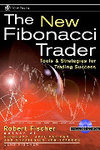- ISBN
- 0471419109
- Author
- Robert Fischer
- Published
- Feb 17, 2012
Use new Fibonacci concepts and the latest technology to turn promising trading ideas into profits
In this groundbreaking new book, Fibonacci expert Robert Fischer and coauthor Jens Fischer build on the foundation of Robert's popular first book Fibonacci Applications and Strategies for Traders to bring you up-to-speed on the new techniques and technology that will allow you to use Fibonacci trading tools/analysis like never before.
The New Fibonacci Trader and companion CD-ROM offer a powerful new arsenal of Fibonacci trading tools and software - WINPHI -to recognize patterns, predict swings, and buck the trend - so you can achieve the highest rate of profitable trades. In-depth analysis of six geometrical Fibonacci trading tools, which are leading indicators, not lagging ones like the instruments of technical analysis . . .
Fibonacci Summation Series
Corrections and extensions
PHI-channels PHI-ellipses PHI-spirals
Fibonacci time goal analysis
. . . and cutting-edge software, which easily chart these tools, will allow you to identify trading opportunities by measuring price and time signals that you would otherwise miss.
Whether you're dealing in stocks, futures, cash currencies, or other financial ventures, The New Fibonacci Trader will help you calculate key turning points in the markets, analyze market cycles, and make disciplined trading possible and profitable.
In this groundbreaking new book, Fibonacci expert Robert Fischer and coauthor Jens Fischer build on the foundation of Robert's popular first book Fibonacci Applications and Strategies for Traders to bring you up-to-speed on the new techniques and technology that will allow you to use Fibonacci trading tools/analysis like never before.
The New Fibonacci Trader and companion CD-ROM offer a powerful new arsenal of Fibonacci trading tools and software - WINPHI -to recognize patterns, predict swings, and buck the trend - so you can achieve the highest rate of profitable trades. In-depth analysis of six geometrical Fibonacci trading tools, which are leading indicators, not lagging ones like the instruments of technical analysis . . .
Fibonacci Summation Series
Corrections and extensions
PHI-channels PHI-ellipses PHI-spirals
Fibonacci time goal analysis
. . . and cutting-edge software, which easily chart these tools, will allow you to identify trading opportunities by measuring price and time signals that you would otherwise miss.
Whether you're dealing in stocks, futures, cash currencies, or other financial ventures, The New Fibonacci Trader will help you calculate key turning points in the markets, analyze market cycles, and make disciplined trading possible and profitable.

